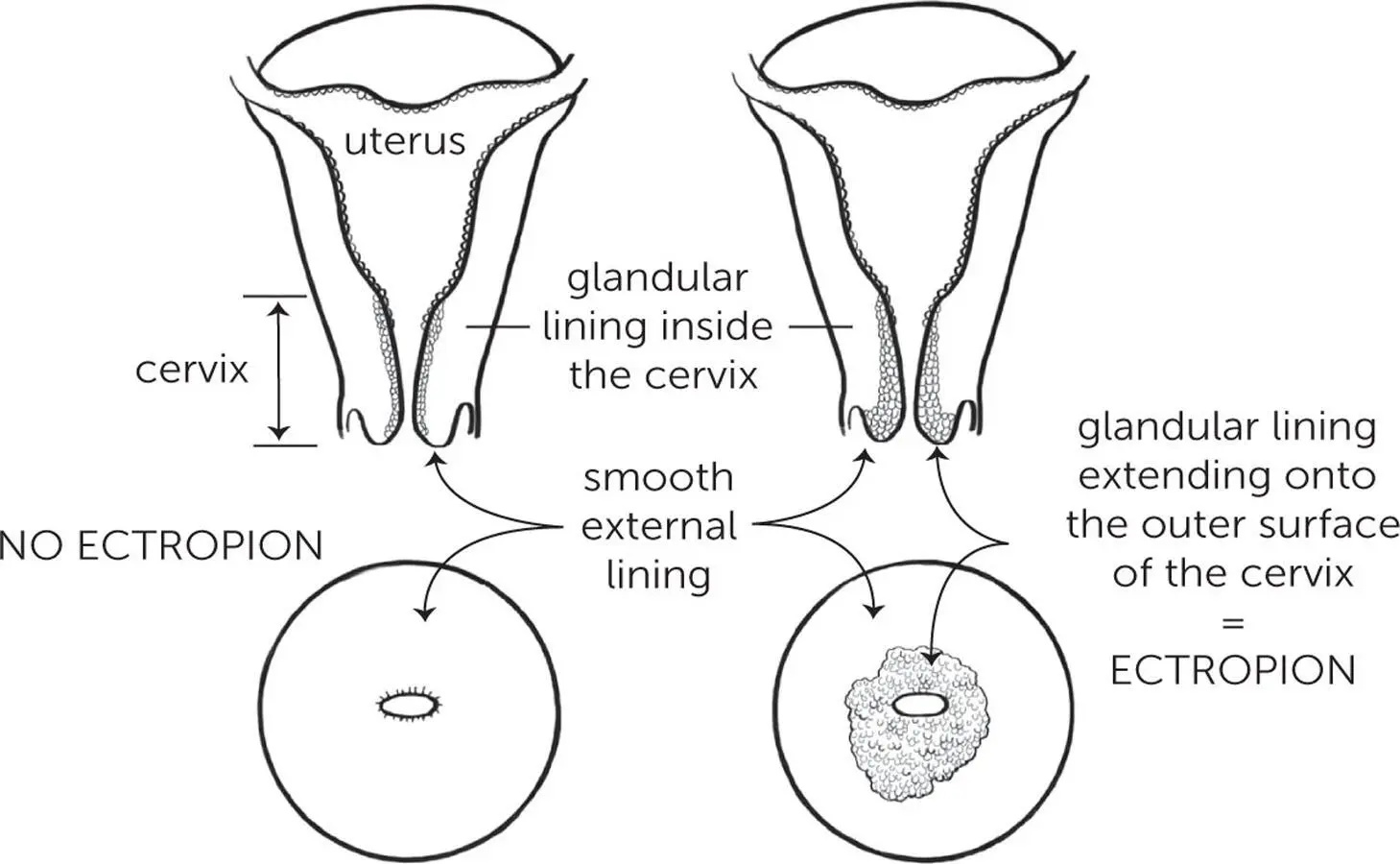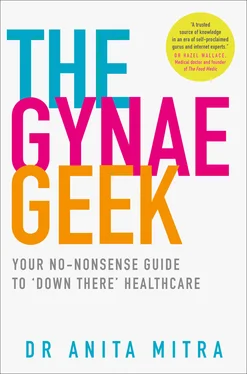The uterus
The uterus is also known as the womb, and we often use the terms interchangeably. I’ll use the word uterus from now on, you know, in the name of being proper and all.
The uterus is a muscular structure found in your pelvis, behind your bladder and in front of your bowel. It’s roughly pear-shaped, although I often describe it to patients as an upside-down wine bottle, with the large part of the bottle representing the body of the uterus and the neck representing the cervix (or neck of the womb), which acts as a passage for sperm to enter the uterus and menstrual blood or babies to exit. The wall of the uterus is made of smooth muscle, which moves in a ripple-type motion as opposed to striated muscle, which is the type you flex on demand in the gym. You might think that your uterus only contracts during labour, and while this may be the time when it performs its most vigorous workout, it also contracts during your period, helping the menstrual blood to escape, and during female orgasm. Given that these contractions are what cause you to have period pain, it’s not unusual for some women to experience a similar kind of pain for a few hours after sex, either due to orgasm-induced contractions or just because their uterus actually gets a bit irritated from being poked about.
Endometrium
The endometrium is the lining of the uterus, and is at its thinnest around your period, gradually thickening throughout the month to make a nice, soft, juicy landing for a fertilised egg. If this doesn’t happen, the lining is shed when you have your period. The thickness of the lining at the end of the month will determine how heavy your period is, and also, to some extent, how painful it may be – because the more there is to shed, the more the muscle of your uterus may need to contract to help move it out through the cervix and down into the vagina.
The cervix
The cervix or ‘the neck of the wine bottle’ is the gatekeeper to the uterus. Not only does it have a mechanical function of keeping your uterus shut during pregnancy, it also has a pretty complex immune function. A large quantity of the vaginal discharge that you produce comes from the cervix. Discharge is clever and anxiety-provoking in equal measures, which is why I have given it its own chapter (see Chapter 6). But until you get to that section, be aware that it’s way more than just a lubricant and contains loads of ‘natural antibiotics’ that protect you against infections, and that changes in the texture and qualities of the discharge throughout the cycle can determine whether sperm is able to enter.
If you feel your cervix (for non-squeamish readers, this involves inserting your finger into your vagina and feeling right at the top), it usually feels like the tip of your nose, because there is a little indentation in the middle. This is called the ‘external os’ and is the entry into the cervical canal; the small tunnel that runs through the cervix up into the cavity of the uterus. The canal is usually only a couple of millimetres wide, but during labour it opens up to 10cm, which is what we call ‘fully dilated’. Prostaglandins are the chemical messengers that cause contraction of your uterus during your period, and they also cause your cervix to soften slightly, opening a tiny bit to allow blood to escape with ease.
Cervical ectropion
An ectropion is an exposed area of the glandular lining of the inside of the cervix. Not everyone has one, but those who do are often terrified. And understandably so, because it is not something that is usually described clearly. So let me give it a go … Normally, the outer cervix is covered entirely with a smooth lining that’s quite tough and similar to the skin lining the inside of the vagina. But the glandular lining is a bit rough in texture, yet more fragile, and produces most of the protective discharge that I’ll cover in Chapter 6. It’s most common to have an ectropion when taking the combined oral contraceptive Pill, or during pregnancy, but loads of women just have one for no particular reason. They’re not associated with a higher risk of abnormal smears, or with any other disease. They can be bloody annoying though – literally. They tend to bleed on contact, such as during a smear test or during/after sex due to the fragile nature of the glandular lining. It doesn’t mean anything is wrong, it’s just that the lining isn’t really designed to be exposed in such a way.

Having said that, lots of women have an ectropion and never know because they don’t all bleed. If you do have one it can go away on its own; especially if you’re on the Pill it will often disappear when you stop taking it. But if the bleeding is really annoying, there are things that can be done to treat it, such as having the exposed glandular layer burned away, which is what a lot of websites will recommend. Many women come to clinic insisting they want it removed; we generally advise against it unless it’s really problematic, and the vast majority change their mind once I’ve explained that it’s not harmful. As one patient once said to me, ‘If it’s nothing sinister, I’ll take a few harmless drops of blood over a barbecue on my cervix any day.’
Cervical polyps
These are little ‘skin tags’ that can be found in the cervix. Many women have them and never know, but in some they cause symptoms of abnormal discharge (a change in colour, texture, amount or bloodstained), bleeding in between periods, after sex or after a gynaecological examination, which makes them super annoying, and a potential source of worry. They may also be found by chance during a routine examination such as a smear test. They can be removed easily in clinic, and it’s quick and painless, but if they’re not causing symptoms this is unnecessary, as they are always benign (non-cancerous) and don’t increase the risk of any kind of disease or trouble in the future. 5
Nabothian follicle
Also called mucus-retention cyst, this is where the mucus that is made as part of the healthy function of the cervix becomes trapped underneath the surface of the cervix. Most often, these cysts are just an incidental finding when you’re having a speculum examination, and they’re usually too small to be felt, although if you touch your cervix, you may be able to feel the little lumps. They are completely normal and don’t increase the risk of any kind of gynaecological disease, nor are they anything to do with sexually transmitted infections. A patient once told me that another doctor described them as spots/whiteheads on her cervix, and she had thought it was because she wasn’t washing her vagina enough; so she went to town with various feminine-hygiene products, which didn’t make them go away and just gave her terrible vaginal irritation. If you have them, you can’t do anything to make them go away and you don’t need to either.
Fallopian tubes
You have two fallopian tubes – one on the left and one on the right, coming off the top of your uterus like long ears that flap around and pick up eggs from the ovaries. I recently scanned a lady who was ecstatic to find out she was seven weeks pregnant. I showed her the pregnancy in the uterus with a heartbeat and told her I could see the egg had come from the left ovary. She looked baffled and said it wasn’t possible because she’d had her left tube removed three years before due to an ectopic pregnancy (where the fertilised egg implants itself outside the uterus, usually in one of the tubes). However, your tubes are incredibly mobile – like a motorbike courier, they’ll pick up from any location if the goods are ready and waiting. So even with one tube, eggs can still be picked up from either ovary. The tubes contain tiny little finger-like projections called cilia, which help to sweep the eggs along into the uterus. However, they are not directly attached to the ovaries, and open into the pelvic cavity, which can serve as a route for infections to spread from your vagina, which is how sexually transmitted infections in particular can spread and cause pelvic inflammatory disease (see Chapter 9).
Читать дальше













